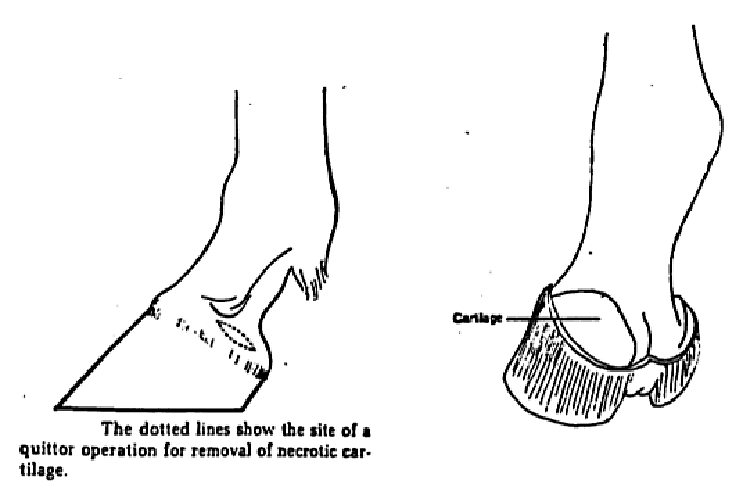Abscess vs. Quittor
InfoHorse.com | 2008
Q. Dear Mr. Smith,
I have a QH mare, aged at 8 yrs, she is currently nursing her 5 month old filly. She has always been in good health, but about 2 wks ago I noticed she was limping (front rt.) I thought maybe she had twisted her foot as her fetlock (ankle) looked swollen. I had a neighbor well knowledged in horses, look at her & he thought she's be okay. Anyway, I've been watching her daily & her eating is good, although she looks like she's lost some weight. She is really hobbling worse these past 2 or 3 days, yet she still moves around. I looked at her hoof & noticed it is leaking fluid, clear. I'm afraid she might have something in it towards the back part of hoof. I'm scared something terrible is wrong. I have been feeding her alfalfa hay, grass hay, & sweet feed for lactating mares & she grazes on bermuda. I'm from Oklahoma (central to western) & it's been very dry, so grass is not lush. Also have salt block for her. Can you tell me what I should do? No horse vet close to where I live. Please, can you give me some advice on what to do for her?
Thank you! Beverly Smith
A. Beverly,
It is difficult to diagnosis your horse's lameness without seeing the horse, but I do not believe that you have a feeding problem. Since her lameness is bilateral (on one foot) I would be very unusual to have a serious systemic disease.
All lamenesses should be seen by and treated by a veterinarian working with a competent farrier. If the discharge becomes thick and colored and/or the lameness remains the same or gets worse you should immediately call a veterinarian.
If your horse's lameness dissipates soon after the fluid discharge than your horse probably has one of two problems. She has either a foot abscess or an abscess of the lateral cartilages, called a quittor.
A foot abscess is a fluid filled pocket that develops between the sensitive and insensitive sole. The fluid filled pocket is created by trauma to the foot, puncture wound, bruise, etc. Cells die as result of the insult or injury. The majority of the mass of a cell is fluid. This fluid is released when the cell dies.
In addition, there is a colony of bacteria that naturally reside in the horse and that bacteria localize in trauma sites. As scavengers they consume dead material with gas and fluid a byproduct of their existence.
When a horse places weight on the hoof the fluid performs a hydraulic action, mechanically separating the sensitive and insensitive sole. This tearing is the pain.
To better understand they dynamics of what is occurring in the horse's foot with an abscess place a drop of water on a piece of glass. Then place another piece of glass on top and watch how much the drop of water spreads. This is the hydraulic action that occurs in the horse's foot.
The fluid is seeking a route to exit. The weakest section of hoof is the connection between sensitive and insensitive structures. If the farrier or veterinarian does not pare out the sole and make an exit point for the fluid to drain then the fluid will continue to tear the connection until it either exits the bottom of the foot, the heel/bulb area or the coronary band.
The discharge will be a clear fluid. Your horse should be fine after the abscess discharges.
A quittor is a chronic inflammation of the collateral cartilage(s) of the foot, usually manifesting itself as an abscess discharging from the top of the cartilage.
A quittor is caused by an infection of the collateral cartilage due to a puncture wound, wire or similar cut or severe bruising to the foot over the area of the collateral cartilage. Bruising may be the result of interfering.
There will be swelling, heat and pain over the coronary band, in the region of the affected collateral cartilage and chronic abscessing that tend to heal and then break open at varying intervals. Lameness may only be present when the abscess is building and subside after the abscess has broken. The abscess sight is just above the coronary band and is reoccurring.
Treatment for a quittor requires a veterinarian as it usually requires surgery.
The way you can tell the difference between an ordinary abscess and a quittor is that a quittor will discharge above the coronary band and an abscess will discharge at the coronary band.
